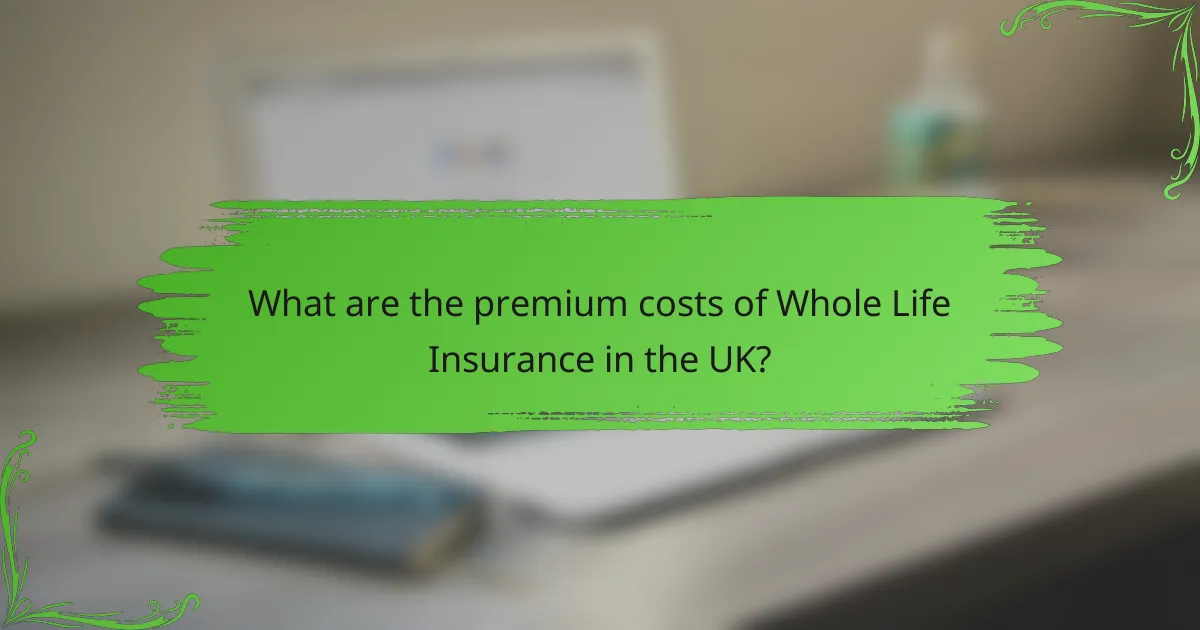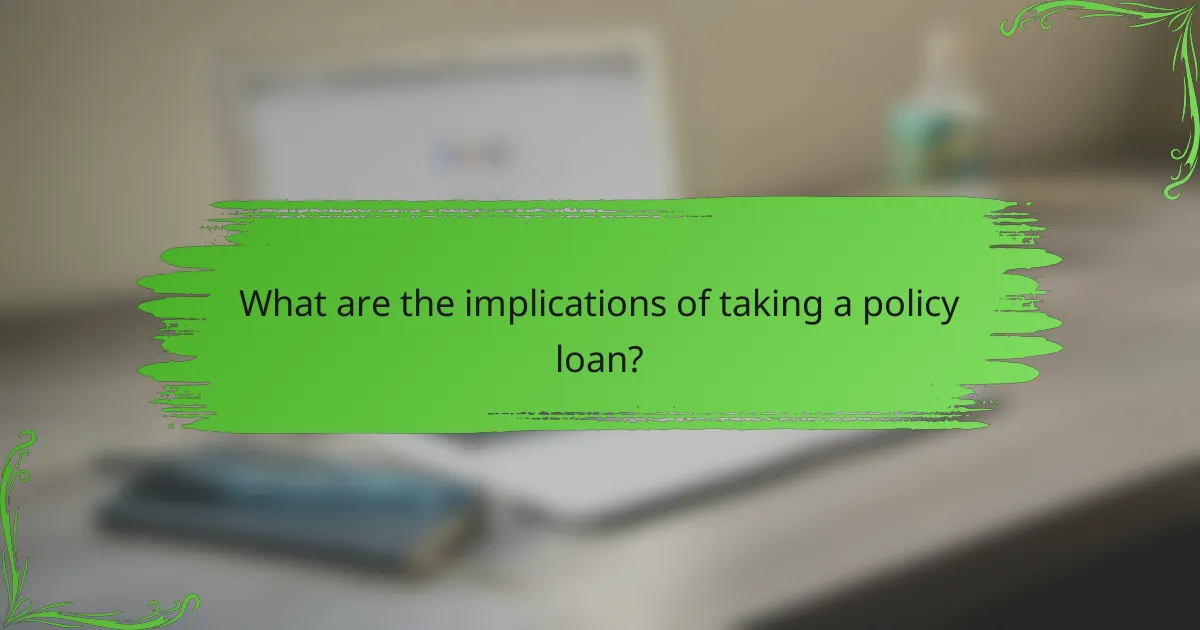Whole life insurance offers a unique blend of lifelong coverage and cash value accumulation, making it a popular choice for many individuals. Premium costs can vary based on factors such as age and health, but they remain consistent throughout the policyholder’s life. As premiums are paid, a portion contributes to a cash value that grows over time, although various fees may affect this growth. Understanding these elements is crucial for making informed decisions about whole life insurance policies.

What are the premium costs of Whole Life Insurance in the UK?
The premium costs of whole life insurance in the UK can vary significantly based on several factors, including the insured’s age, health, and the coverage amount. Typically, premiums are paid monthly or annually and remain constant throughout the policyholder’s life.
Average premium rates
On average, whole life insurance premiums in the UK can range from a few hundred to several thousand pounds per year. For example, a healthy individual in their 30s might pay between £300 and £600 annually, while older applicants may see rates exceeding £1,000. These averages can fluctuate based on the insurer and specific policy features.
Factors affecting premium costs
Several key factors influence the premium costs of whole life insurance. Age is a primary determinant, as younger applicants generally receive lower rates due to a longer life expectancy. Health conditions, lifestyle choices like smoking, and the amount of coverage desired also play significant roles in determining premiums.
Additionally, the insurer’s underwriting process can affect costs. Some companies may offer more competitive rates based on their assessment criteria, so it’s essential to compare multiple providers.
Comparison of providers
When comparing whole life insurance providers in the UK, consider not only the premium costs but also the policy features and benefits. Some insurers may offer additional options, such as accelerated death benefits or cash value growth, which can enhance the overall value of the policy.
It’s advisable to obtain quotes from at least three different providers to identify the best coverage for your needs. Online comparison tools can simplify this process, allowing you to evaluate premiums and features side by side.

How does cash value accumulate in Whole Life Insurance?
Cash value in whole life insurance accumulates over time as part of the policy’s guaranteed benefits. A portion of each premium payment contributes to this cash value, which grows at a steady rate, allowing policyholders to access funds during their lifetime.
Cash value growth over time
The cash value in a whole life insurance policy typically grows at a guaranteed rate, often around 2-4% annually, depending on the insurer. This growth is compounded, meaning that the interest earned on the cash value also earns interest over time. As a result, the longer the policy is held, the more substantial the cash value can become.
Additionally, many policies may offer dividends, which can further enhance cash value growth. These dividends are not guaranteed but can provide an extra boost, especially in profitable years for the insurance company.
Impact of premium payments on cash value
Premium payments play a crucial role in determining the cash value of a whole life insurance policy. Typically, a higher premium will lead to a larger cash value accumulation, as more funds are allocated toward the cash value component. It’s essential to understand how much of your premium goes toward cash value versus the cost of insurance.
For example, in the early years of a policy, a significant portion of the premium may cover administrative fees and insurance costs, resulting in slower cash value growth. Over time, as these costs decrease relative to the premium, more of the payment contributes to cash value, enhancing its growth potential.

What are the fees associated with cash value in Whole Life Insurance?
Whole life insurance policies often include various fees that can impact the cash value accumulation. These fees can include administrative costs, mortality charges, and surrender fees, which together influence the overall growth of the policy’s cash value.
Common fees and charges
Common fees associated with whole life insurance policies include premium load charges, which are deducted from your premium payments, and administrative fees for managing the policy. Additionally, there are mortality and expense charges that cover the insurer’s risk and operational costs. Surrender charges may apply if you withdraw funds or cancel the policy within a specified period, typically the first 10 to 15 years.
Some policies may also have a cost of insurance (COI) that increases as the insured ages, impacting the cash value growth. It’s essential to review the policy documents to understand all applicable fees and how they are calculated.
How fees affect cash value
The fees associated with whole life insurance can significantly reduce the cash value accumulation over time. For instance, if the total fees amount to a substantial percentage of your premiums, the cash value may grow at a slower rate than anticipated. This can lead to a situation where the cash value is less than what you might expect based on the premium payments made.
To mitigate the impact of fees on cash value, consider policies with lower administrative and mortality charges. Additionally, regularly reviewing your policy performance and understanding the fee structure can help you make informed decisions about your coverage and cash value utilization.

How can policy loans be accessed in Whole Life Insurance?
Policy loans in Whole Life Insurance can be accessed by borrowing against the cash value of the policy. This allows policyholders to obtain funds without needing to undergo a credit check or provide collateral, as the loan is secured by the policy itself.
Loan application process
The loan application process for Whole Life Insurance is typically straightforward. Policyholders can request a loan by contacting their insurance provider, either through an online portal or by speaking to a representative. Most companies allow for quick access to funds, often processing requests within a few business days.
To initiate a loan, you will generally need to provide your policy number and specify the amount you wish to borrow. It’s advisable to check with your insurer for any specific forms or documentation required.
Loan terms and conditions
Loan terms and conditions can vary by insurer but generally include interest rates that are competitive with market rates. The interest on the loan accrues over time and is typically added to the outstanding balance if not paid. It’s crucial to understand that unpaid loans can reduce the death benefit and cash value of the policy.
Most insurers allow policyholders to borrow up to a certain percentage of the cash value, often around 90%. Always review your policy details to understand the implications of taking a loan, including how it may affect your financial planning and insurance coverage.

What are the implications of taking a policy loan?
Taking a policy loan against your whole life insurance can affect both your cash value and death benefit. It’s crucial to understand how these loans work and the potential consequences before proceeding.
Impact on death benefit
When you take a policy loan, the amount borrowed is deducted from your death benefit. If the loan is not repaid, the insurer will subtract the outstanding loan balance plus any accrued interest from the total death benefit paid to your beneficiaries. This means that your loved ones may receive significantly less than the policy’s face value if the loan remains unpaid at the time of your passing.
For example, if your policy has a death benefit of $100,000 and you take a loan of $20,000, your beneficiaries would only receive $80,000 if the loan is not repaid. It’s essential to consider this impact when deciding to borrow against your policy.
Interest rates on policy loans
Interest rates on policy loans typically range from low single digits to mid-teens, depending on the insurer and the policy terms. This interest accrues on the outstanding loan balance, which can increase the total amount owed over time. It’s important to review your policy’s specific loan provisions to understand the applicable rates and how they may change.
When considering a policy loan, weigh the interest costs against the benefits of accessing cash. If the interest rate is higher than what you might earn on other investments, it may be more prudent to explore alternative funding options. Always calculate the total cost of borrowing to make an informed decision.

What are the alternatives to Whole Life Insurance?
Alternatives to whole life insurance include term life insurance and universal life insurance, each offering different benefits and structures. Understanding these options can help you choose the best policy for your financial goals and needs.
Term life insurance comparison
Term life insurance provides coverage for a specified period, typically ranging from 10 to 30 years. It is generally more affordable than whole life insurance, making it a popular choice for those seeking cost-effective protection during critical financial years, such as raising children or paying off a mortgage.
One key trade-off is that term policies do not build cash value, meaning they only pay out if the insured passes away during the term. If you outlive the policy, you receive no benefits, which can be a significant consideration for long-term planning.
Universal life insurance overview
Universal life insurance is a flexible permanent life insurance option that combines a death benefit with a cash value component. Policyholders can adjust their premiums and death benefits, allowing for greater adaptability to changing financial situations.
This type of insurance typically has lower premiums than whole life insurance and allows for potential cash value growth based on market interest rates. However, it is essential to monitor the policy regularly to ensure it remains adequately funded and to avoid lapsing due to insufficient cash value.


